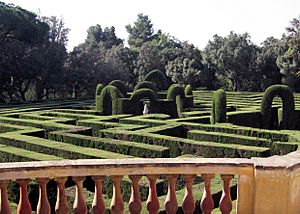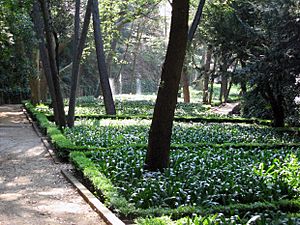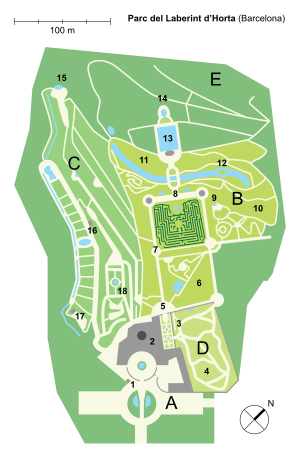Parc del Laberint d'Horta facts for kids
Quick facts for kids Parc del Laberint d'Horta |
|
|---|---|
 |
|
| Type | Historical garden |
| Location | Barcelona |
| Created | 1791 |
| Status | Open all year |
The Parc del Laberint d'Horta (which means "Park of the Labyrinth of Horta") is a very old and beautiful garden in Barcelona, Spain. It's the oldest garden of its kind in the city! This park used to be part of the Desvalls family's large estate. It sits near the Collserola mountains.
The park has two main parts: an 18th-century garden with a neoclassical style and a 19th-century garden with a romantic style. The most famous part, and what gives the park its name, is the amazing hedge maze located on the lower terrace.
Contents
Exploring the Park's Features
Right when you enter the park, you'll see the old palace of the Desvalls family. This building has cool designs that mix old Arabic and Gothic styles. There's also an ancient medieval watchtower called the Torre Sobirana nearby.
The park is huge, covering about 9.1 hectares of land. It's split into two main areas: the neoclassical garden and the romantic garden. All around the park, you'll find many interesting sculptures. Some of these sculptures show characters and stories from Greek mythology. Others have designs inspired by local folk tales. You can also discover many fountains, natural springs, and pools throughout the park.
The Neoclassical Garden
The neoclassical garden is designed with three different levels or terraces:
- The Lower Terrace: This is where you'll find the famous hedge maze. It's made from 750 meters of carefully trimmed cypress trees! At the entrance to the maze, there's a marble carving called a bas-relief. It shows the Greek heroes Ariadne and Theseus. In the very center of the maze, there's a statue of Eros, the god of love.
- The Middle Terrace: Just above the maze, on the next level, there are two beautiful Italian-style buildings. They have tall Tuscan columns and statues of Danae and Ariadne. These buildings look like small, round Roman temples. Near the big staircase that leads to the top level, you'll see a statue of Dionysus, who was the Greek god of wine and fun.
- The Upper Terrace: This is the highest part of the neoclassical garden. Here, you'll find a special building dedicated to the nine muses, who were goddesses of art and science. On top of this building is a sculpture that shows art and nature working together. Below it, you can read a Latin phrase: Artis Naturaque Parit Concordia Pulchrum. This means "The harmony of art and nature generates beauty." On the other side, it says: Ars Concors Foetum Naturae Matris Alumbrat, which means "Harmonic art gives light onto the fruit of Mother Nature." Behind this building, there's a large pond filled with water from a natural spring.
The Romantic Garden
The romantic garden is designed with many flower beds and small open areas. These spots are shaded by very large trees. At the northern edge of this part of the park, there's a lovely waterfall. Not much of the original design is left, but it seems this garden was built to make people think about themes like death. There even used to be a small replica of a graveyard here, but it's gone now. In contrast, the neoclassical garden is all about the theme of love.
The beautiful gardens of the park are surrounded by a large area of Mediterranean forest.
Interesting Facts
- The park's gardens have hosted the kings and queens of Spain three times for special events.
- The buildings on the middle terrace were used by a famous poet named Joan Maragall to put on classic plays. For example, on October 10, 1898, a play called Iphigenia in Tauris by Goethe was performed there. Joan Maragall himself translated the play.
Images for kids
See also
 In Spanish: Parque del Laberinto de Horta para niños
In Spanish: Parque del Laberinto de Horta para niños











